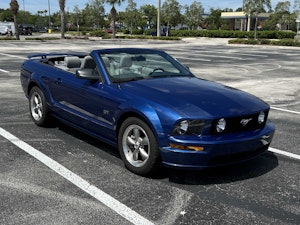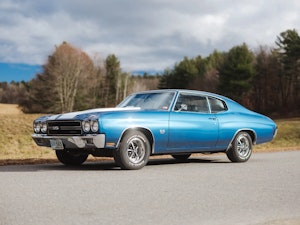Media | Articles
How to Prevent a Car Fire
It’s almost time for getting our classics out of storage and ready for the show season, cruising and just plain pampering. There are some things to consider regarding car fires that you should be aware of.
Checking for fuel line leaks, which are a potential fire when coupled with engine heat, can eliminate a large source of vintage car fires. Those old fuel and transmission fluid lines deteriorate over time. A well-adjusted or rebuilt carburetor will also prevent fuel leaks.
Another potential problem comes from aging electrical systems. By looking for frayed wires, or those that have come too close to exhaust manifolds, we can repair them before they become a problem. Brakes that hang up, especially on that first spring ride after sitting engaged all winter, cause heat if they don’t release, which could spread to other parts of the car.
How many nice chrome or dressed-up fire extinguishers have you seen in a vintage muscle car? It’s not a bad idea to have at least a UL-listed 5A 10BC* rated unit in the car where it can be reached quickly while someone is using the cell phone to dial 911.
If you’re like me, I look forward to having my ‘70 Corvette convertible in the garage for big projects during the colder weather. The shop needs some fine-tuning to keep our cars safe.
Marketplace
Buy and sell classics with confidence
Believe it or not, rags with flammable liquids, strippers or some combustible degreasers can self-ignite if stored together. A metal can with a tight-fitting lid will contain the rags. Discarding them away from the garage after use is better yet.
Debris or combustibles piled in the garage can give a place for sparks to go off. On a 5 degree evening last winter, we responded to a house fire that was ignited when a cutting operation put sparks into some accumulated scrap. The owner went into the house, little realizing that a fire had started. It extended through the walls to a bedroom above, the kitchen and then the roof. Nine months later, the family might be able to move back into their house in another month.
Items to keep handy in the shop include at least one extinguisher with a rating of 5A 40BC* (I like to have one at each end of the shop) and some oil dry or cat litter to pick up combustible liquids and keep the fumes down (as the fumes are what burns). These are easy to sweep up and dispose of as well.
A great shop will have plenty of light and outlets. The classic “drop light” in several convenient locations can give plenty of light without tripping over the cords or running them over the car’s finish. Drop-light bulbs of the “Rough Use” type will lessen the frustration of dropping the drop light and having the bulb go out or break. An incandescent drop light makes enough heat to ignite combustible liquids or rags. Be sure to check the wiring on these and other tools for fraying or open spots.
Plenty of GFI outlets should be used, as should separate circuits of the correct amperage for those high-draw items like a compressor or welder.
If you’re lucky enough to be able to renovate your shop for more comfort’s sake, some improvements such as using 5/8 sheetrock on the walls and ceilings, putting in a 1-hour fire-rated door between the garage and house and putting a 4-inch step to the house to prevent fumes from entering and finding a source of ignition, would be money well spent.
So spring will finally be here and it’s time to put the top down for a ride, but the battery has run down during storage. Before using the trickle charger, make sure to check its wiring. I’ve been to a garage fire where the charger was hooked up and left. It shorted out or “fried” the battery and the car burned.
Also, when the shop manual says to disconnect the battery, do so. If you have occasion to drain flammable liquids, a container with a funnel top that can be closed after filling is helpful. This type of operation should be done in a well-ventilated area.
The Letters
Class A fires are the most common type around the house, involving ordinary combustibles such as wood, paper, cloth, rubber and plastics.
Class B fires involve flammable liquids (e.g., gasoline, kerosene, oil), gases and greases. These are most common in the garage, and vehicles. Class C fires involve live electrical appliances, equipment or wiring. Class C extinguishers are suitable for use on electrically energized fires.
The Numbers
Class A: The number preceding Class A indicates the approximate extinguishing potential. This number relates to the square feet of ordinary combustible material the extinguisher can put out and is dependent on the type of extinguisher, as well as efficiency of the operator (a firefighter may actually be able to put out a 10 square foot Class A fire with a 10A extinguisher, but an inexperienced citizen may not come close to putting the fire out).
Class B: The number used for Class B indicates the square footage of a deep-layer flammable liquid fire that a trained operator can put out.
When to Fight Fire
Personal safety for yourself and others is the most important factor when deciding whether to fight a small fire. It is dangerous to fight a fire in any circumstances. If in doubt, leave immediately, close off the area to slow the spread of the fire and smoke, and wait outside for the fire department to arrive.
If a car fire involves only upholstery (for example, a fire in the back seat started by a cigarette), use any fire extinguisher. If the fire involves the engine or dashboard, however, the fire could quickly become very dangerous. These fires should be fought with an extinguisher that has a B:C or ABC rating. Do not open the hood; aim through the car’s grill. If you can’t extinguish the fire immediately, leave the area, keep everyone far away from the car and wait for the fire department.
It’s very important that the type of extinguisher you use is appropriate for the type of fire you’re fighting. If you spray water on a grease fire, the water will cause the grease to splatter and the fire may spread. If you spray live electrical equipment with water, you suffer the risk of electrical shock. Dry chemical extinguishers are usually rated for multi-purpose use. They contain an extinguishing agent and use a compressed, non-flammable gas as a propellant.
— Jeff Allyn, Hagerty Protection Network member and a Midland Park volunteer firefighter in Midland Park, NJ.










